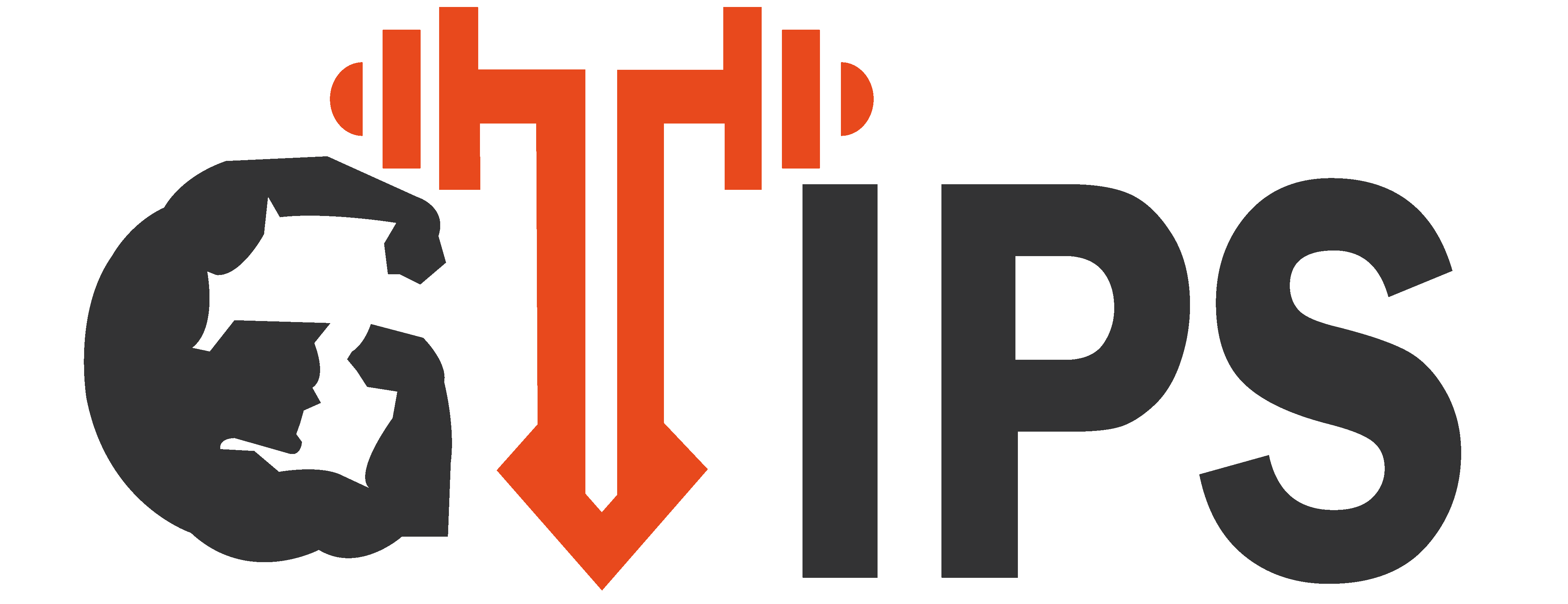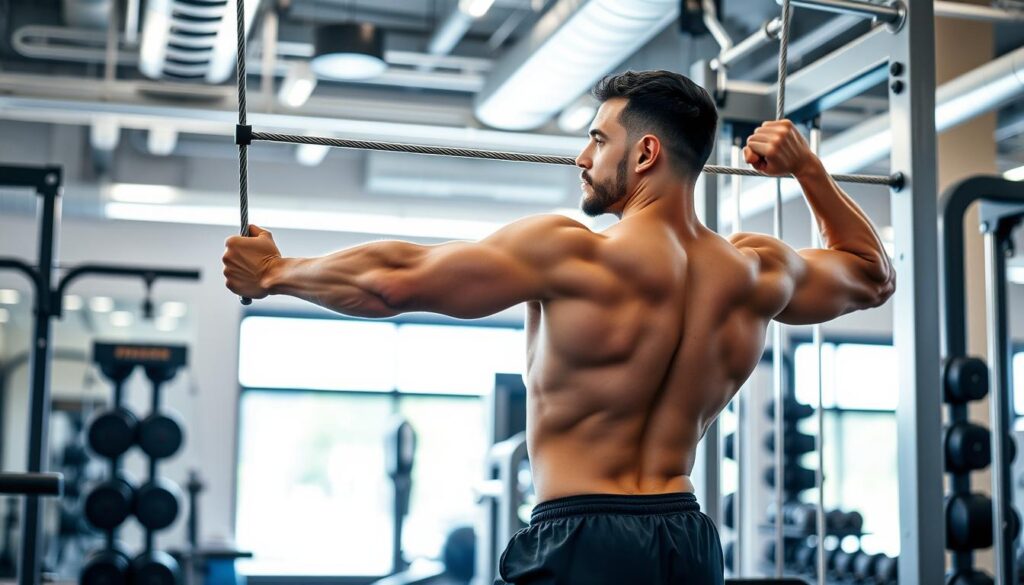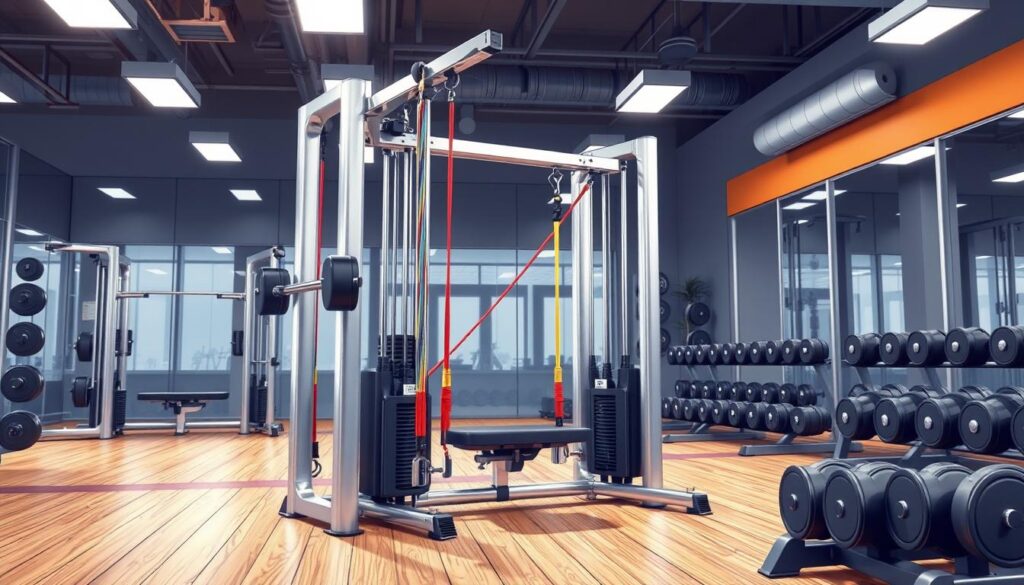Imagine walking into the gym, eager to boost your chest and upper body strength. As you reach the cable station, excitement builds. The cable crossover is a favorite among bodybuilders and fitness fans. It promises to shape, strengthen, and define your chest muscles like nothing else.
The cable crossover is more than a simple chest workout. It opens the door to a stronger, more balanced body. By learning the right form and technique, you’ll gain many benefits. These include better shoulder stability, stronger core, and a deeper connection between your mind and muscles.
In this detailed guide, we’ll dive into the cable crossover. We’ll cover the muscles it targets and its importance in your fitness routine. Get ready to improve your workouts and enhance your physique with the cable crossover.
Key Takeaways
- The cable crossover is a versatile chest exercise that targets the pectoral muscles with constant tension.
- Proper form and technique are essential for maximizing the benefits of the cable crossover and avoiding injury.
- The cable crossover can be performed using a cable crossover machine or resistance bands, making it accessible for both gym and home workouts.
- Incorporating the cable crossover into your routine can help build muscle mass, increase strength, and improve shoulder mobility.
- Progression and variation are key to continuously challenging your muscles and driving results with the cable crossover.
Understanding Cable Crossover Benefits and Muscle Activation
The cable crossover is a versatile exercise that targets many muscles. It mainly works the pectoralis major and pectoralis minor. It also engages the anterior deltoids, rhomboids, levator scapulae, and latissimus dorsi muscles. This makes it great for building a stronger, more defined upper body.
Primary Muscle Groups Targeted
The cable crossover exercise puts constant tension on the pectoralis major and pectoralis minor muscles. This can lead to more muscle growth in the chest than exercises like the bench press.
Secondary Muscle Benefits
The cable crossover also works the anterior deltoids, rhomboids, levator scapulae, and latissimus dorsi. This helps improve upper body strength, stability, and balance. It’s good for sports training and activities that need strong shoulders.
Advantages for Strength Development
The constant resistance from cable machines during the cable crossover exercise boosts muscle activation and stability. This leads to more efficient strength building and muscle growth. You can also adjust the resistance to keep challenging your muscles as you get stronger.
“The cable crossover exercise is renowned for its versatility, allowing you to target both the lower and upper chest muscles with a single movement.”
Essential Equipment and Setup Requirements
To master the cable crossover exercise, you need the right gear and setup. The main piece of equipment is a cable crossover machine. These machines have adjustable arms or pulleys. They let you target specific muscles by changing the cable height and grip.
If you can’t get a cable crossover machine, resistance bands are a great alternative. They offer constant tension, letting you mimic the cable crossover movement. This way, you can challenge your muscles in a similar way.
Whether using a machine or bands, make sure the cable or band is at or above shoulder level. This helps engage the muscles you want to work. You can find various handles and attachments for a comfortable grip.
Setting up involves adjusting the cable height, picking the right weight or resistance, and positioning yourself. Taking your time to get the setup right ensures you do the exercise correctly. This way, you get the most out of it for your strength and muscle growth.
Proper Form and Technique for Cable Crossover
To get the most out of the cable crossover exercise, it’s important to use the right form and technique. This ensures you target the right muscles, like your chest, safely. By learning the proper form, you can work your chest effectively without harming your joints.
Starting Position and Grip
Start by holding the cable handles with your palms facing down. Your arms should be slightly behind your body. Keep a slight lean forward and a wide stance to stay balanced and in control.
Movement Execution
Begin the exercise by focusing on your chest muscles, not your arms. Pull your arms across your body until your hands meet at chest level. Don’t bend your elbows too much or swing the weight. Move slowly and deliberately with each rep.
Common Form Mistakes to Avoid
- Don’t use momentum to swing the weight. This can hurt your muscles and increase injury risk.
- Keep your elbows slightly bent to keep proper form and engage your chest.
- Make sure your hands meet at the center of your chest, not higher or lower.
Following the right cable crossover form and exercise execution boosts the exercise’s benefits and lowers injury risk. Learning the proper technique is key to building a stronger, more defined chest.
“Proper form is key when doing the cable crossover to get the most muscle activation and avoid injury.”
| Common Cable Crossover Mistakes | Proper Technique |
|---|---|
| Using momentum instead of controlled movement | Execute each rep with deliberate, controlled motion |
| Excessive elbow bending | Maintain a slight bend in the elbows throughout the movement |
| Failing to cross hands at chest level | Ensure your hands meet at the center of your chest |
Optimizing Your Cable Crossover Workout
To get the most out of your cable crossover workout, it’s key to place it right in your routine. Do the cable crossover at the end of your chest or upper body workout. This way, you really work your chest muscles, helping them grow.
For building muscle, aim for 3 sets of 10-12 reps. This rep range is great for growing muscles. As you get stronger, you can add more weight or change the cable height to keep challenging yourself.
Advanced trainees might use cable crossovers before doing big exercises like bench presses or push-ups. This method exhausts your chest muscles, letting you push harder on the next exercises.
No matter your level, keep a strong mind-muscle connection during the cable crossover. Focus on controlling the weight and moving through the full range of motion. Try different hand positions and cable angles to work different chest areas.
Proper breathing technique is also key. Breathe in as you open your arms, and out as you squeeze your chest. This helps you stay focused and connected to your muscles.
“Mastering the cable crossover is a game-changer for building a strong, well-defined chest. By incorporating it strategically into your routine, you’ll unlock new levels of muscle growth and strength.”
By following these tips, you’ll improve your cable crossover workout and boost your chest training. Keep practicing, focus on proper form, and increase the challenge to reach your muscle-building goals.
Advanced Cable Crossover Variations
Take your chest workout to the next level with these advanced cable crossover variations. Try new techniques that target specific muscles and introduce new movements. This keeps your training exciting and effective.
Single-Arm Crossovers
Add single-arm cable crossovers to your routine. They challenge your core and focus on each side of your chest. This unilateral movement strengthens your stabilizers and improves muscle balance.
Low-to-High Variations
Focus on your upper chest with low-to-high cable crossovers. Start with the cables low to target the clavicular head of the pectoralis major. This helps build a more defined upper chest.
High-to-Low Variations
For the lower chest, try high-to-low cable crossovers. This variation isolates the sternal head of the pectoralis major. It provides a targeted workout for the lower pectoral area.
These advanced techniques prevent plateaus and address muscle imbalances. Experiment with different variations and increase the resistance as you get stronger. Always focus on proper form to get the most out of these exercises.
Training Volume and Programming Guidelines
To get the most out of cable crossover workouts, you need a smart plan for training volume and programming. For muscle growth, aim for 3-4 sets of 8-12 reps with a weight that’s not too light, not too heavy. This range is perfect for building muscle, as it challenges your chest muscles and helps you get stronger over time.
If you want to boost your muscle endurance, try 2-3 sets of up to 20 reps with lighter weights. This method helps you build stamina and keeps your muscles working hard for longer.
When adding cable crossovers to your routine, train your chest 1-2 times per week. This lets your muscles recover and grow stronger. As you get stronger, increase the weight, reps, or sets to keep pushing your chest muscles.
To make your cable crossover workout even more effective, try supersets or drop sets. Supersets mean doing two exercises one after the other with little rest. Drop sets involve lowering the weight and continuing until you can’t do any more reps.
“Keeping detailed workout logs is essential for tracking progress and ensuring continuous growth in your cable crossover routine.”
Always listen to your body and adjust your training as needed. Make sure to keep proper form during your cable crossover exercises. With consistent, progressive, and thoughtful programming, you’ll see great results from this powerful chest-building exercise.
Safety Considerations and Injury Prevention
When doing cable crossovers, safety is key. It’s important to warm up right and manage risks to avoid injuries. This makes your workout safe and effective.
Proper Warm-up Techniques
Start with a light cardio to get your blood flowing. Then, do dynamic stretches for your chest and shoulders. This gets you ready and reduces injury risk.
Risk Management Strategies
Keep your form right to avoid injuries. Stand up straight, use your core, and don’t swing the weight. Don’t lock your elbows at the end, as it stresses your joints. If your shoulders hurt, adjust the cable or ask a fitness expert for help.
Always put safety first. If you feel pain, stop right away. With the right precautions, you can enjoy cable crossovers safely.
“Proper warm-up and risk management are essential to ensure a safe and effective cable crossover workout.”
Incorporating Cable Crossovers into Your Routine
Adding cable crossovers to your chest workout can really boost your upper body strength. This exercise targets the main chest muscles and also works other muscles. It gives you a full workout for your upper body.
Use cable crossovers as a finishing move after big exercises like bench presses or push-ups. Or, do them before heavy lifts. This makes sure your chest muscles are really tired, leading to better growth.
For a complete chest workout, mix cable crossovers with exercises like incline and decline presses. This variety hits all parts of your chest, making it look balanced and sculpted.
Try mixing free-weight and cable exercises in your routine. This keeps your workouts interesting and stops you from getting stuck in a routine.
Change how often and how many sets you do of cable crossovers based on your training and how well you recover. Start with 3-4 sets of 10-15 reps and light weights if you’re new. As you get better, add more weight and reps to keep challenging yourself.
“Cable crossovers are a great exercise for building a strong, defined chest. By incorporating them into your routine, you’ll see impressive gains in muscle size and strength.”
By smartly adding cable crossovers to your chest workout routine, you can reach new levels in your upper body. Always focus on good form, increasing the weight, and a balanced program to meet your workout planning goals.
Progressive Overload Strategies
To keep making progress with cable crossovers, use progressive overload strategies. Start by adding a little more weight each time. Or, try doing more reps or sets. You can also change how fast you move the weight.
Try slower movements or pause at the strongest point. Use drop sets or rest-pause to work your muscles harder. This will help you get stronger and build more muscle.
Always check how you’re doing and change your workout as needed. Make sure to increase the load slowly to avoid injuries. By pushing yourself a bit more each time, you’ll see better results and reach your goals faster.
Using different ways to increase the challenge in your cable crossover workouts can help you overcome plateaus. Stay committed and flexible in your training to get the most out of this powerful exercise.
FAQ
What are cable crossovers and how do they target the chest?
Cable crossovers are a great way to work your chest muscles. They provide constant tension and allow for deep muscle stretch. This makes them effective for targeting different parts of the chest.
What are the primary and secondary muscle groups targeted by cable crossovers?
Cable crossovers mainly work the pectoralis major and minor muscles. They also engage the anterior deltoid, rhomboids, levator scapulae, and latissimus dorsi muscles.
What are the benefits of performing cable crossovers?
Cable crossovers improve strength, muscle mass, and shoulder mobility. They also enhance chest definition and vascularity. The constant tension helps build strength and muscle efficiently.
What equipment is needed for cable crossovers, and how should it be set up?
You’ll need a cable crossover machine with adjustable arms or pulleys. Resistance bands can be used for a home workout. Set the cable height at or slightly above shoulder level for the standard version.
How do you perform the cable crossover exercise with proper form?
Start by grabbing the handles with palms facing downward, arms slightly behind your torso. Keep a slight forward lean and a wide stance for stability. Move your arms across your body, focusing on your chest muscles.
How can you optimize your cable crossover workout for muscle growth?
Do cable crossovers at the end of your chest or upper body training day. Aim for 3 sets of 10-12 reps. Keep a strong mind-muscle connection and control the weight throughout the movement.
What are some advanced cable crossover variations to target different areas of the chest?
Try single-arm crossovers, low-to-high variations, and high-to-low variations. These can prevent plateaus, target specific chest areas, and add variety to your workout.
How should you program cable crossovers within your overall chest workout routine?
Use cable crossovers as a finishing exercise after compound movements or as a pre-exhaust exercise before heavier lifts. Mix them with exercises targeting different angles for a well-rounded chest workout.
How can you implement progressive overload strategies to continue making progress with cable crossovers?
Gradually increase the weight used while keeping proper form. You can also increase the number of reps or sets. Try slower eccentric phases or paused contractions at peak tension.
What safety considerations should you keep in mind when performing cable crossovers?
Always warm up before starting. Keep proper posture and avoid using momentum. Don’t lock out your elbows at the end. If you feel shoulder pain, adjust the cable height or seek advice from a fitness professional.






